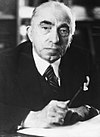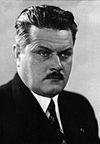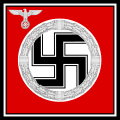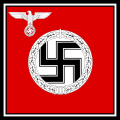
The Sudetenland is the historical German name for the northern, southern, and western areas of former Czechoslovakia which were inhabited primarily by Sudeten Germans. These German speakers had predominated in the border districts of Bohemia, Moravia, and Czech Silesia since the Middle Ages. Since the 9th century the Sudetenland had been an integral part of the Czech state both geographically and politically.

The military occupation of Czechoslovakia by Nazi Germany began with the German annexation of the Sudetenland in 1938, continued with the creation of the Protectorate of Bohemia and Moravia, and by the end of 1944 extended to all parts of Czechoslovakia.
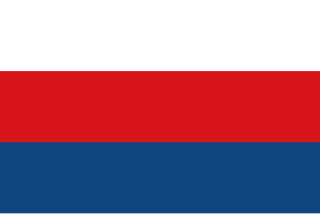
The Protectorate of Bohemia and Moravia was a partially-annexed territory of Nazi Germany that was established on 16 March 1939 after the German occupation of the Czech lands. The protectorate's population was mostly ethnic Czech.

The flag of the Czech Republic is the same as the flag of the former Czechoslovakia. Upon the dissolution of Czechoslovakia in December 1992, the Czech Republic kept the Czechoslovak flag while Slovakia adopted its own flag. The first flag of Czechoslovakia was based on the flag of Bohemia and was white over red. This was almost identical to the flag of Poland, so a blue triangle was added at the hoist in 1920. The flag was banned by the Nazis in 1939 as they established a government nominally in control of Bohemia and Moravia, and a horizontal tricolour of white, red, and blue was used for the duration of the war. The 1920–1939 flag was restored in 1945.

Emil Dominik Josef Hácha was a Czech lawyer, the president of Czechoslovakia from November 1938 to March 1939. In March 1939, after the breakup of Czechoslovakia, Hácha was the nominal president of the newly proclaimed German Protectorate of Bohemia and Moravia.

Kurt Max Franz Daluege was a German SS and police official who served as chief of Ordnungspolizei of Nazi Germany from 1936 to 1943, as well as the Deputy/Acting Protector of Bohemia and Moravia from 1942 to 1943.

Karl Hermann Frank was a Sudeten German Nazi official in the Protectorate of Bohemia and Moravia prior to and during World War II. Attaining the rank of Obergruppenführer, he was in command of the Nazi police apparatus in the protectorate, including the Gestapo, the SD, and the Kripo. After the war, he was tried, convicted and executed by hanging for his role in organizing the massacres of the people of the Czech villages of Lidice and Ležáky.
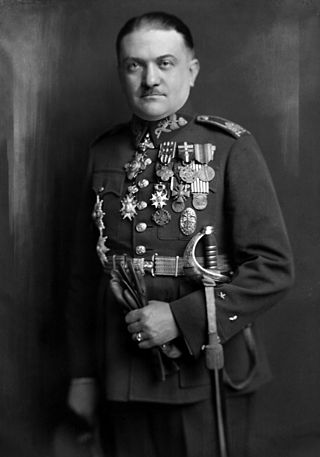
Alois Eliáš was a Czech general and politician. He served as prime minister of the puppet government of the German-occupied Protectorate of Bohemia and Moravia from 27 April 1939 to 27 September 1941 but maintained contact with the government-in-exile. Because of his participation in the anti-Nazi resistance, he was the only head of government who was murdered by the Nazis during World War II.

Jaroslav Krejčí was a Czech lawyer and Nazi collaborator. He served as the prime minister of the Protectorate of Bohemia and Moravia from 28 September 1941 to 19 January 1945.

Richard Bienert was a Czech high-ranking police officer and politician. He served as prime minister of the Protectorate of Bohemia and Moravia from January 19 to May 5, 1945. After World War II he was sentenced to prison for collaboration with Nazis.

Emanuel Moravec was a Czech army officer and writer who served as the collaborationist Minister of Education of the Protectorate of Bohemia and Moravia between 1942 and 1945. He was also chair of the Board of Trustees for the Education of Youth, a fascist youth organisation in the protectorate.

Ležáky, in the Miřetice municipality, was a village in Czechoslovakia. During the German occupation of Czechoslovakia, it was razed by Nazi forces as reprisal for Reich Protector Reinhard Heydrich's assassination in late spring 1942.

Český národně socialistický tábor — Vlajka was a Czech fascist, antisemitic and nationalist movement. Vlajka's eponymous newspaper was founded in 1928, its first editor being Miloš Maixner. During the time of German occupation, the organisation collaborated with the Nazis for which it was banned and its members were punished after the liberation.

The Second Czechoslovak Republic, officially the Czecho-Slovak Republic, existed for 169 days, between 30 September 1938 and 15 March 1939. It was composed of Bohemia, Moravia, Silesia and the autonomous regions of Slovakia and Subcarpathian Rus', the latter being renamed Carpathian Ukraine on 30 December 1938.

Czechoslovak resistance to the German occupation of the Protectorate of Bohemia and Moravia during World War II began after the occupation of the rest of Czechoslovakia and the formation of the protectorate on 15 March 1939. German policy deterred acts of resistance and annihilated organizations of resistance. In the early days of the war, the Czech population participated in boycotts of public transport and large-scale demonstrations. Later on, armed communist partisan groups participated in sabotage and skirmishes with German police forces. The most well-known act of resistance was the assassination of Reinhard Heydrich. Resistance culminated in the so-called Prague uprising of May 1945; with Allied armies approaching, about 30,000 Czechs seized weapons. Four days of bloody street fighting ensued before the Soviet Red Army entered the nearly liberated city.

The Final Solution of the Czech Question was the Nazi German plan for the complete Germanization of the Protectorate of Bohemia and Moravia. Nazi German sociologist and anthropologist Karl Valentin Müller asserted that at least half (50%) of the Czech nation was "racially Aryan" and could be Germanized. This was in stark contrast to Germany's Final Solution to the Jewish Question, which called for the total extermination of the Jews save for a select "honorary Aryans". Müller asserted that Germanization of the Czechs could be first attempted without coercion; instead, he suggested a system of social incentives.
Obrana národa was a Czech resistance organization that fought against the German occupation from 1939 to 1945. It opposed Nazi rule in the Protectorate of Bohemia and Moravia. The group was founded by General Josef Bílý in April 1939.

Josef Valčík was a Czechoslovak British-trained soldier and member of the Resistance in German-occupied Czechoslovakia who took part in the firefight during the aftermath of the assassination of Reinhard Heydrich by Jozef Gabčík and Jan Kubiš, code named Operation Anthropoid.

The Holocaust in Bohemia and Moravia resulted in the deportation, dispossession, and murder of most of the pre-World War II population of Jews in the Czech lands that were annexed by Nazi Germany between 1939 and 1945.

Arijský boj was a pro-Nazi Czech-language weekly tabloid newspaper published between May 1940 and May 1945 in the Protectorate of Bohemia and Moravia. Inspired by the Nazi newspaper Der Stürmer, the newspaper made antisemitism its main theme and was also critical of the Czechoslovak government-in-exile. Denunciations published by the newspaper contributed to the isolation of Jews during the first years of the Holocaust in Bohemia and Moravia.


